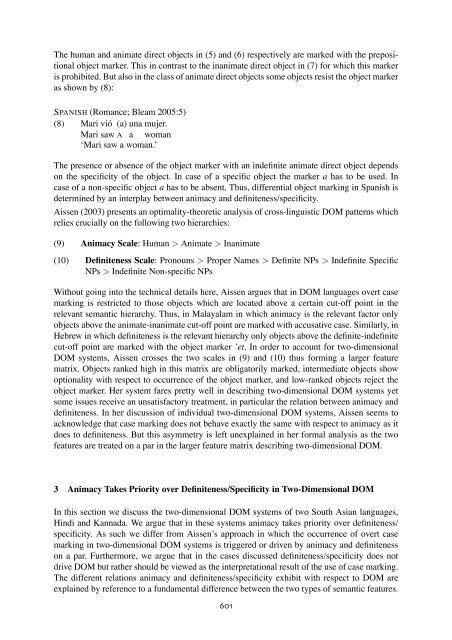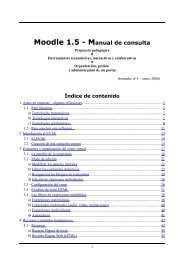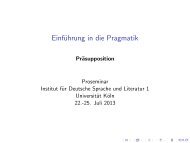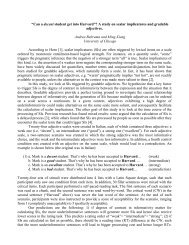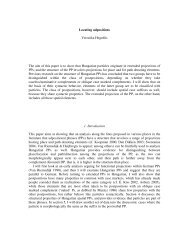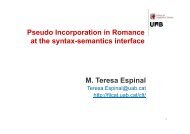Semantic aspects of differential object marking - corpora@parles.upf ...
Semantic aspects of differential object marking - corpora@parles.upf ...
Semantic aspects of differential object marking - corpora@parles.upf ...
You also want an ePaper? Increase the reach of your titles
YUMPU automatically turns print PDFs into web optimized ePapers that Google loves.
4 Peter de Swart and Helen de Hoop<br />
The human and animate direct <strong>object</strong>s in (5) and (6) respectively are marked with the prepositional<br />
<strong>object</strong> marker. This in contrast to the inanimate direct <strong>object</strong> in (7) for which this marker<br />
is prohibited. But also in the class <strong>of</strong> animate direct <strong>object</strong>s some <strong>object</strong>s resist the <strong>object</strong> marker<br />
as shown by (8):<br />
SPANISH (Romance; Bleam 2005:5)<br />
(8) Mari vió (a) una mujer.<br />
Mari saw A a woman<br />
‘Mari saw a woman.’<br />
The presence or absence <strong>of</strong> the <strong>object</strong> marker with an indefinite animate direct <strong>object</strong> depends<br />
on the specificity <strong>of</strong> the <strong>object</strong>. In case <strong>of</strong> a specific <strong>object</strong> the marker a has to be used. In<br />
case <strong>of</strong> a non-specific <strong>object</strong> a has to be absent. Thus, <strong>differential</strong> <strong>object</strong> <strong>marking</strong> in Spanish is<br />
determined by an interplay between animacy and definiteness/specificity.<br />
Aissen (2003) presents an optimality-theoretic analysis <strong>of</strong> cross-linguistic DOM patterns which<br />
relies crucially on the following two hierarchies:<br />
(9) Animacy Scale: Human > Animate > Inanimate<br />
(10) Definiteness Scale: Pronouns > Proper Names > Definite NPs > Indefinite Specific<br />
NPs > Indefinite Non-specific NPs<br />
Without going into the technical details here, Aissen argues that in DOM languages overt case<br />
<strong>marking</strong> is restricted to those <strong>object</strong>s which are located above a certain cut-<strong>of</strong>f point in the<br />
relevant semantic hierarchy. Thus, in Malayalam in which animacy is the relevant factor only<br />
<strong>object</strong>s above the animate-inanimate cut-<strong>of</strong>f point are marked with accusative case. Similarly, in<br />
Hebrew in which definiteness is the relevant hierarchy only <strong>object</strong>s above the definite-indefinite<br />
cut-<strong>of</strong>f point are marked with the <strong>object</strong> marker ’et. In order to account for two-dimensional<br />
DOM systems, Aissen crosses the two scales in (9) and (10) thus forming a larger feature<br />
matrix. Objects ranked high in this matrix are obligatorily marked, intermediate <strong>object</strong>s show<br />
optionality with respect to occurrence <strong>of</strong> the <strong>object</strong> marker, and low-ranked <strong>object</strong>s reject the<br />
<strong>object</strong> marker. Her system fares pretty well in describing two-dimensional DOM systems yet<br />
some issues receive an unsatisfactory treatment, in particular the relation between animacy and<br />
definiteness. In her discussion <strong>of</strong> individual two-dimensional DOM systems, Aissen seems to<br />
acknowledge that case <strong>marking</strong> does not behave exactly the same with respect to animacy as it<br />
does to definiteness. But this asymmetry is left unexplained in her formal analysis as the two<br />
features are treated on a par in the larger feature matrix describing two-dimensional DOM.<br />
3 Animacy Takes Priority over Definiteness/Specificity in Two-Dimensional DOM<br />
In this section we discuss the two-dimensional DOM systems <strong>of</strong> two South Asian languages,<br />
Hindi and Kannada. We argue that in these systems animacy takes priority over definiteness/<br />
specificity. As such we differ from Aissen’s approach in which the occurrence <strong>of</strong> overt case<br />
<strong>marking</strong> in two-dimensional DOM systems is triggered or driven by animacy and definiteness<br />
on a par. Furthermore, we argue that in the cases discussed definiteness/specificity does not<br />
drive DOM but rather should be viewed as the interpretational result <strong>of</strong> the use <strong>of</strong> case <strong>marking</strong>.<br />
The different relations animacy and definiteness/specificity exhibit with respect to DOM are<br />
explained by reference to a fundamental difference between the two types <strong>of</strong> semantic features.<br />
601<br />
4


